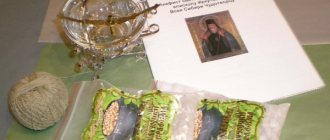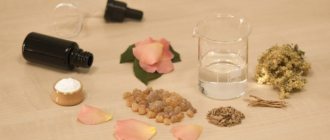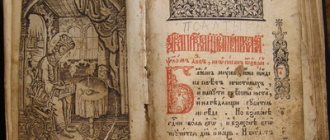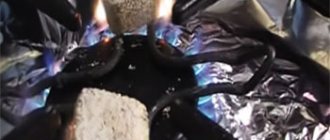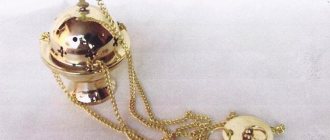Let's admit it: we all talk about it, discuss it, regularly mention and refer to it, but we don't have the slightest idea what it is. We are talking about forgotten, downtrodden or never familiar things from well-known expressions. What can you say to a friend returning from vacation? For example (with a minimal tendency to grandiosity): “Welcome to your native land! Friend!". By the way, what are “penates”? You probably won't be able to tell without Google. What is “suseki”? "Baklushi"? "Lyasy"? It's time to look into and declassify these verbal agents serving for the benefit of the Ministry of Sustainable Combinations.
Breathing on your last breath
First of all, yes, that's how it's spelled. Not “adjusted”, not “adjusted” and other phonetic processes, but on an incense. Frankincense is the hardened resin of the incense tree that gives off a strong odor when burned; essentially incense. Why breathe on it? Strictly speaking, it’s not necessary - it’s just that the smell of smoking incense was once actively loved by the clergy of Christian churches. And since some of the actions of the clergy are built around the funeral service or preparation for the funeral service, people have a sad association: the smell of incense means death. Well, breathing on it means being close to some very, very unpleasant situation.
Origin
The reader must have been to church. And he remembers quite clearly the sweetish smell that permeated the entire room. This is what incense smells like. And it all started a long time ago. This smell turned out to be pleasant to the priests, and since then many rituals of God's temple began to include this resin. Yes, yes, this is the resin of a plant of the same name. In order not to confuse the reader, let's say that the tree is Frankincense. If you ever go to Yemen and Oman as a tourist, you will definitely come across something that is associated with the smell of your native church.
And since the smell of tree resin is firmly connected with the church, not only in the minds of believers, but also in essence, the expression “breathing incense,” the meaning of which we are analyzing, is not difficult to unravel. Not only bright rituals are performed surrounded by the aroma of incense, but also sad ones. For example, those that precede a person’s journey to a better world.
Native Penates
In a good way, the word “Penates” should be written with a capital letter - this is not Repin’s estate, not a hotel, not a bookstore - this is the name of ancient Roman deities. The Romans believed that in every house there lived a couple of Penates who guarded the hearth. It was good practice to keep somewhere a cabinet with clay (3D printers did not yet exist) images of these Roman brownies.
If any positive events happened in the family, the Penats should have been fed - to appease and thank them for their good service. When the family moved, they took Penat (both the figurines, and in the religious sense) with them - they would protect life in the new place. Soon these deities became synonymous with home and homeland for the entire country. Accordingly, “return to one’s native land” means to return home, under one’s own roof.
In the picture, by the way, it’s not Penates, but Laras – but there’s not much difference between them.
Scrape the bottom of the barrel
If you are five years old and you are dreaming about a school desk, or if you are twenty-five and you have a five-year-old child dreaming about a school desk, you have probably come across the word “boobs” in that same action-packed fairy tale where the treacherous Fox, the naive Bear and the restless Kolobok. However, and not only there - in the old days they often said “they are kneading the dough,” implying the modern version of “living within your means.” So what kind of bottoms are these?
And it’s simple, the bottom is a bin; a special wooden chest in a barn or other utility room. There, earth workers poured grain, flour or stored vegetables. Yes, and the word must be written in the singular - rarely did anyone need several parts at once. By the way, here’s a reason for you to think about the logical component of the same fairy tale. In many versions, the Old Woman scraped precisely “on the bottom of the barrel.” There were a lot, that is, there were boons. Hence the question: were they really that poor? Why did they need so many holes if they couldn’t fill even one? Is the fairy tale not about a choleric bun, but about the dizzying financial fall of a retired couple? Questions, questions.
Halvan fragrant (galbanum)
Galbanum milky juice
But most of all, scientists had to tinker with a substance called onycha. Translated from Greek, this word means “nail”, in Aramaic translation it means “tufra”, also “nail”. This word had several interpretations, so scientists had to conduct serious linguistic research to find out the only correct meaning. As a result, they came to the conclusion that onycha is nothing more than the valve of a spiral shell of a special type of mollusk living in the Red Sea. Chemists have found that its leaves, ground into fine powder, have been used in medicine since ancient times.
Health Blend
Having collected all four components, experts began making miraculous incense. All components were brought from the areas of their historical origin. Scientists ground shells and resins and mixed them in equal parts (as indicated in the text of the Old Testament).
The resulting mixture was tested on experimental animals: two independent experiments were carried out with an interval of a month. Laboratory rats were infected with artificial peritonitis and divided into two groups of 10 animals. After that, one group was fumigated with the resulting incense for 15 minutes, and the second group was the control. As a result, in both experiments, four and five animals from the first group survived, respectively, while all rats in the control groups died.
The result amazed scientists. Biblical incense in its essence turned out to be a powerful immunomodulator, that is, a substance that can influence the immune system. Moreover, it was many times superior in properties to, for example, honey or cranberries. But why does it have such wonderful properties?
Further research by chemists clarified the situation somewhat: it turns out that when all the components were combined, a new homogeneous mixture with completely special properties arose.
Using a spirit lamp, the experimenters sublimated incense at the bottom of the glass. And a slide of an optical microscope was installed above the container - particles of the evaporating substance settled on it. After 15 minutes, the glass was examined under a microscope with a thousandfold magnification and it was found that a coating with particles had formed on the surface, each of which was a micron in size or less. But when we did the same with each individual component of incense, practically no such small particles were observed. If the components were sublimed separately, granules ranging in size from 5 to 30 microns were formed.
All this largely explains the miraculous properties
Aerosols and smoke with particles sized microns or smaller can hang in the air for a long time without settling. If such a suspension is sprayed once in a room, it can hang in the air for a day - this creates a regime of constant inhalation. That is, incense can affect the body for a long time.
It is quite possible that it was precisely this property that was taken into account when the sick were fumigated with incense. In the room where the sick person was, aerosols, as the personification of light forces, filled the entire space, displacing evil forces, or in our opinion, viruses and microbes.
In addition, particles smaller than a micron in size can easily enter the alveoli of the lungs. Particles larger than a micron collide with the walls of the trachea and do not reach the alveoli. Substances are absorbed into the blood in the alveoli. The ingestion of particles of “biblical” incense into the body can be compared to intravenous administration, when the substance acts instantly and enters the body evenly over a long time. This does not happen when individual elements of incense are burned.
Non-random combination
How could such a high-tech substance be obtained in Old Testament times? Scientists are confident that it is impossible to combine all four rare components by chance.
Moreover, it is not clear how our distant ancestors figured out to describe this composition as the only correct one, although they did not know the fundamental principles on which the action of incense is based.
After all, the biological properties of aerosols with submicron particle sizes were discovered only at the end of the last century. The Old Testament was written from the 13th to the 1st centuries BC.
However, the fact is clear: in ancient times, humanity received a recipe for a powerful universal immunomodulator. And the one who discovered it had incomprehensible knowledge in the fields of physiology, physics and chemistry.
Heals body and soul
The strong, sweet, balsamic scent of incense is familiar to anyone who has attended a church service at least once. What miraculous properties does the source of this aroma have?
— Frankincense heals wounds, helps in the treatment of various respiratory diseases, and rejuvenates the skin.
— Incense smoke contains substances that have an antidepressant effect. In ancient Babylon, incense was called upon to cleanse the soul. Today, frankincense essential oil is produced, which really helps to cope with stress and nervous exhaustion, eliminates fears, anxieties, and insomnia.
— In the old days they said about cherubic incense (unburnt pieces of incense that remain in the censer after walking during the performance of the Cherubic song) that it not only relieves illnesses, but also helps in treasure hunting.
Sharpen the laces
A little old-fashioned (it’s unlikely to come out of the lips of a mustacheless youth), but the popular expression implies sharpening... lyas? In fact, this phraseological unit comes from “sharpen balusters.” Balusters are carved railing posts (see photo), sharpening them means making a fancy mesh of patterns. This occupation is tedious, long and, in fact, useless, hence “sharpening wood” as a designation for meaningless, empty chatter.
However, there is another version. Doctor of Philology and Professor of St. Petersburg State University Valery Mokienko says that lyas (and balas) go back to the Slavic basis “bal” - that is, to tell. And “to sharpen” - in this case, not “to grind”, but “to exude”.
For example, speech - and it turns out that “sharpening lasses” means emitting sounds, words.
Goof
Perhaps the only catchphrase that is actively used by readers of this text. Politicians in their speeches, ordinary citizens in line to see a therapist, and even Noize MC in the satirical song “Blatnyak” get into trouble. Meanwhile, hardly anyone understands well what a hole is - and why getting into it is very bad.
Take a closer look at the picture. It's a bit like a spinning loom, isn't it? In principle, it is so - this is the same problem: a rope mill on which stern men spun strong ropes. At the base of the spinning wheel, the rope stuck together so tightly that any entry of something foreign into it would invariably end in failure. And since the fashion for a beard came not a couple of years ago, but centuries earlier, the hair could get into trouble - and its owner would lose not only his beard, but, sometimes, his life. The wise (and already beardless) ancestors remembered this danger and called it “getting into trouble” - that is, in an extremely unpleasant situation.
Synonyms
Semantic analogues are a real help, especially when it comes to such a phenomenon as phraseological units. Some of them are difficult to understand the first time. Let's think about how we can replace the meaning of “breathe into incense.” So:
- to be barely alive;
- feel very bad;
- be in a deplorable state;
- have one foot in the grave;
- the days are numbered;
- lie on your deathbed.
All synonyms, like phraseological units, say that a person is about to appear before the Creator, but, however, this may also be an erroneous judgment, a false idea.
There is one very remarkable illustration in this sense. In the movie The Godfather: The Second Movie, there is a character named Hyman Roth. He always acts as if he has one foot in the grave, and he himself is plotting evil against Michael Corleone. What does this teach? Because appearances are deceiving.
Beat your head
Your grandmother could well have said these two cherished words in your youth, watching your multi-hour marathon in GTA. Of course, you can’t explain to the old woman that Tommy Vercetti is important, but now you can tell her why beating yourself up is not such an empty exercise.
Backwoods were a piece of unprocessed wood, which was then used to make something useful for kitchen utensils - for example, a spoon. The backbone really needed to be beaten: put the workpiece in a special hole with a small hole and hammer it with a chisel until a depression characteristic of a spoon appeared. Such unpretentious work was carried out either by teenagers or children in general; unskilled work, the modern equivalent is distributing leaflets. At first, the expression simply meant an activity that did not require any skills, but over time it acquired its current meaning: to kick the bucket - to mess around.
Have questions about phraseological units? Ask in the comments!
